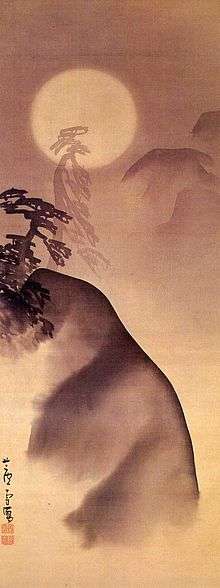Nagasawa Rosetsu
| Nagasawa Rosetsu | |
|---|---|
 | |
| Born |
1754 Yamashiro, Japan |
| Died | 1799 |
| Nationality | Japanese |
Nagasawa Rosetsu (長沢芦雪, 1754–1799) was an 18th-century (Edo period) Japanese painter of the Maruyama School, known for his versatile style. He was born to the family of a low-ranking samurai. He studied with Maruyama Ōkyo in Kyoto.[2][3]
Life
There are conflicting versions of Rosetu's family origins, but the most credible appears to be that he was born to the family of a low-ranking samurai named Uesugi Hikouemon in the area of modern Kyoto Prefecture. Upon establishing himself as an artist, he changed his name from Uesugi to Nagasawa. He moved to Kyoto in 1781, where he became a student of Maruyama Ōkyo.
Rosetsu was married and had four children, all of whom died in childhood. He adopted his pupil Nagasawa Roshū. Rosetsu, his children, and his pupil are buried in a Kyoto cemetery belonging to the Pure Land Sect, although Rosetsu was a lay student of Zen.[4]
Works
Rosetsu's early period works are in the style of Maruyama Ōkyo, although critics agree that the pupil's skill quickly surpassed his master's. Finally, they had a falling out and Rosetsu left the school. After the break, he worked under the patronage of the feudal lord of Yodo and accepted commissions at several temples.
Rosetsu's paintings fall into two very clearly defined categories, with no halfway stage in between. On the one hand, there are those of studied finish, and on the other, those--the great majority--that were clearly the work of a very few minutes of intense activity, whatever the preliminary thought and calculation. We are inclined to think of the first type as early and even untypical, but in fact Rosetsu seems to have executed carefully finished paintings at all stages of his career.[5]
He incorporated aspects of Western realism into Japanese themes.[6] In his work, which is reminiscent of earlier Zen painting,[7] while the moon is left white, the night sky, mountains, and pine trees are depicted with gradations of India ink.
His work was extensively forged in the Meiji period.
See also
![]() Media related to Nagasawa Rosetsu at Wikimedia Commons
Media related to Nagasawa Rosetsu at Wikimedia Commons
References
- ↑ Heritage of Japanese Art by Ichimatsu Tanaka and Masao Ishizawa (1992) p.133
- ↑ Roberts, Laurance (1976). A Dictionary of Japanese Artists. Tokyo and New York: Weatherhill. p. 131. ISBN 0-8348-0113-2.
- ↑ Discovering the Arts of Japan: A Historical Overview by Tsuneko S. Sadao, Stephanie Wada, and Tomoko Miho (2003) p.214
- ↑ Moes, Robert (1973). Rosetsu: Exhibition of Paintings by Nagasawa Rosetsu. Denver, Colorado: Denver Art Museum. pp. 95–98.
- ↑ Hillier, Jack (1974). The uninhibited brush: Japanese art in the Shijō style. London: Hugh M. Moss Ltd. pp. 58–66. ISBN 0902717065.
- ↑ Human Accomplishment: The Pursuit of Excellence in the Arts and Sciences, 800 B.C. to 1950 by Charles Murray (2004) p.327
- ↑ Zen in Ten: Easy Lessons for Spiritual Growth (Ten Easy Lessons Series, 2) by C. Alexander, Ph.D. Simpkins and Annellen M., Ph.D. Simpkins (2003) p.69
External links
| Wikimedia Commons has media related to Nagasawa Rosetsu. |
- Bridge of dreams: the Mary Griggs Burke collection of Japanese art, a catalog from The Metropolitan Museum of Art Libraries (fully available online as PDF), which contains material on Nagasawa Rosetsu (see index)
- Nagasawa Rosetsu (wiki-fr)
